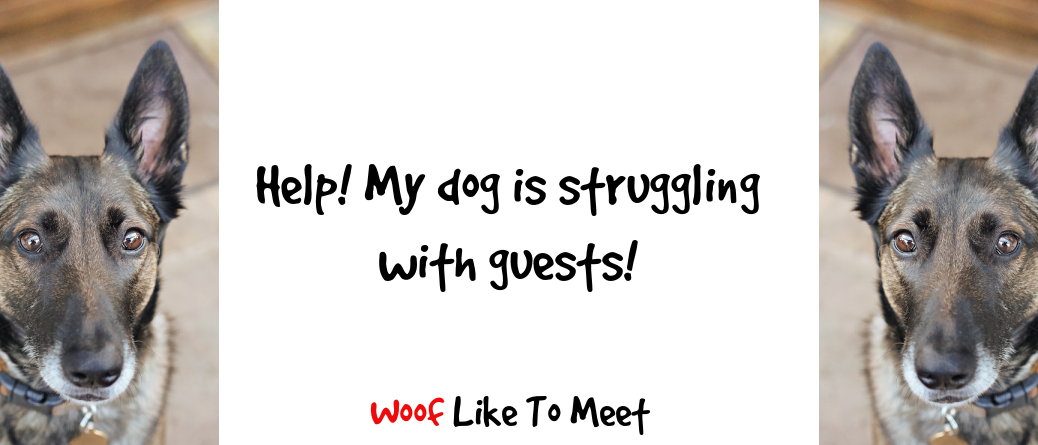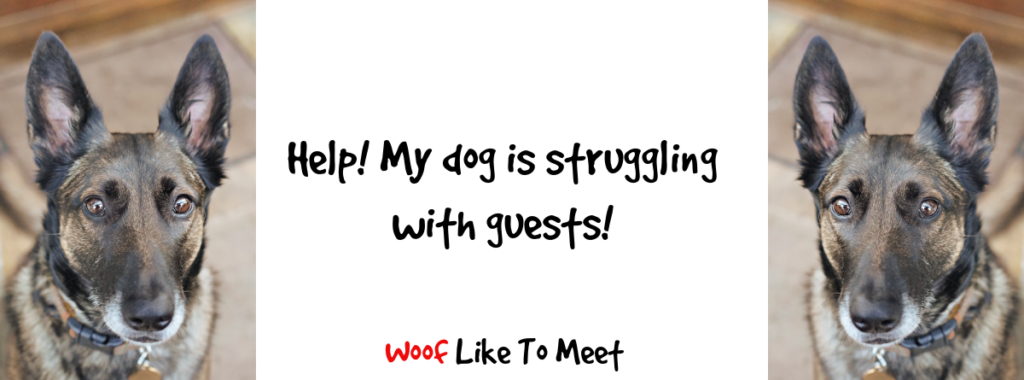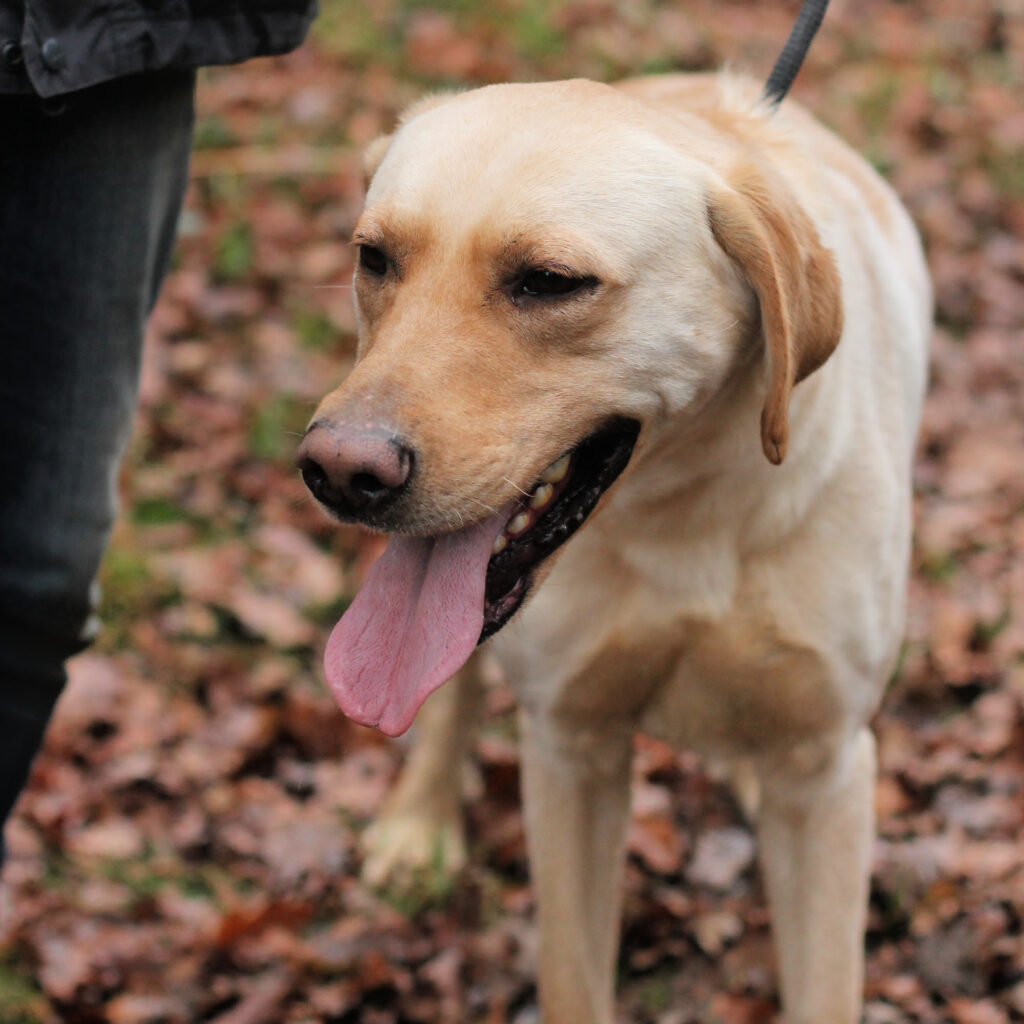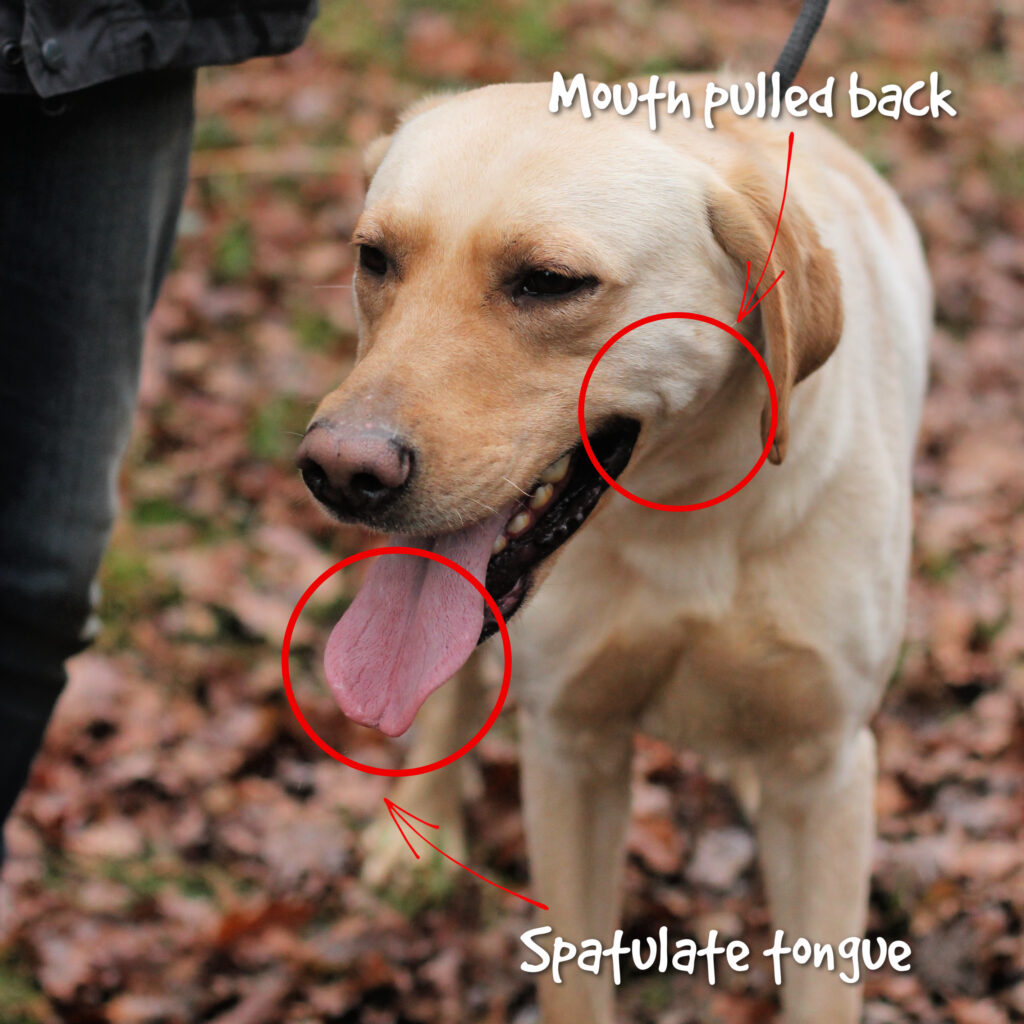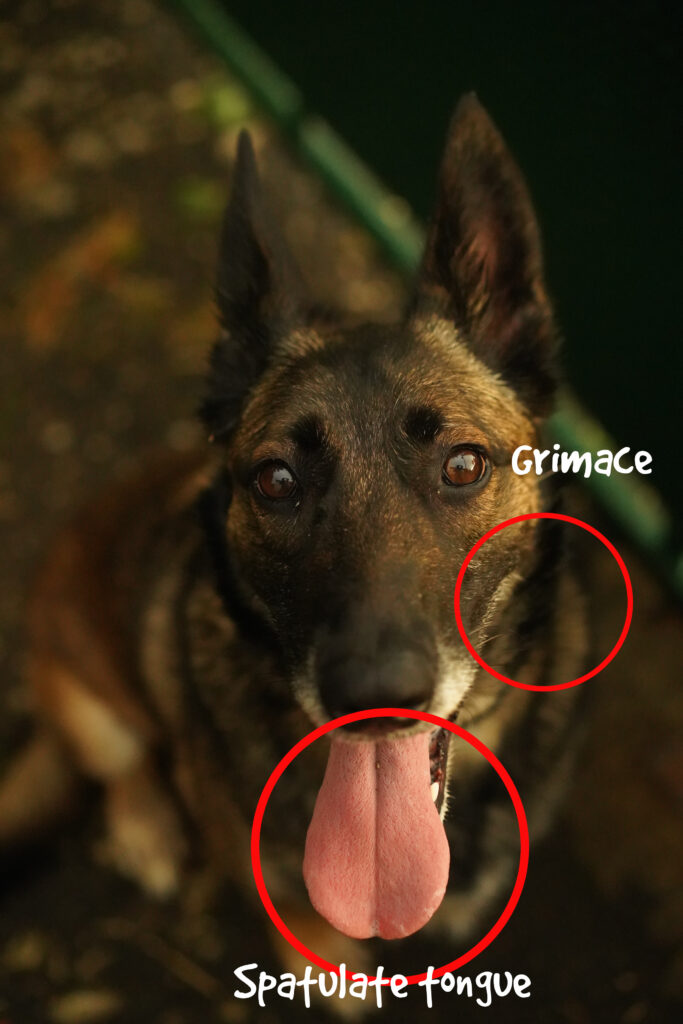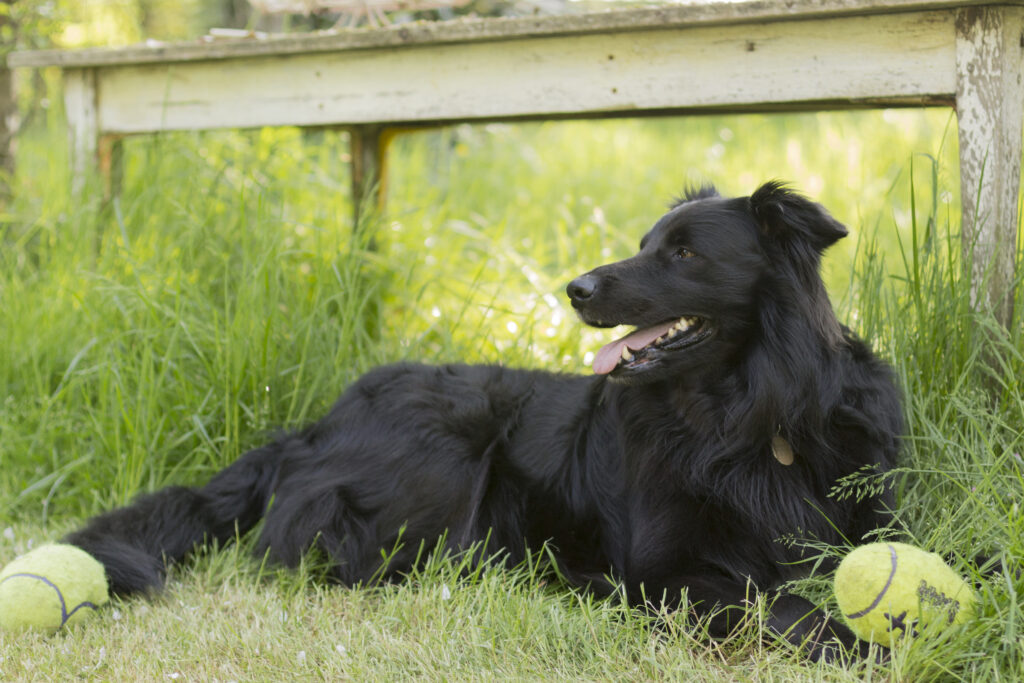Whether you’ve got a young dog who’s struggling to cope with people coming and going, or whether you’ve adopted an older dog who is having issues, it can be pretty common for dogs not to like strangers coming on to the property.
One thing I find really sad is that many people overlook ‘friendly’ behaviour like jumping up or running round in circles as meaning that their dog is fine with visitors. The grimace, the over-friendly behaviours, even taking toys to the guest can be ways that some dogs cope with arrivals into the home. Other behaviours are sometimes seen as harmless if not amusing, like humping. Nobody is looking out for those dogs who aren’t coping as well as they might seem to be on the surface.
For instance, many people would probably think this dog here is coping okay. He’s not jumping up, he’s still, he’s ‘calm’.
Of course, we can never really look at a decontextualised still image and say ‘this dog is X’ or ‘this dog is Y’.
Yet you can tell from the coat and trousers the person is wearing that it is not warm. Panting when the dog hasn’t been engaged in aerobic exercise or when it’s not hot is often a sign of stress or pain. How do I know Heston isn’t feeling so good this morning? Because it’s 16°C and he’s panting. How do I know Lidy couldn’t cope with the fireworks on Saturday? Panting.
The dog may not actually be breathing heavily or panting. That spoon-like tongue is another signal that the dog doesn’t feel comfortable.
A grimace in itself isn’t very meaningful: context and other body language tells us everything, but where I can see wrinkles on the edge of the dog’s mouth, that’s a good sign they are holding some tension, especially with a spatulate tongue. Just a reminder too that not all dogs will do this, and not all of these signs relate to stress.
Here you can see Lidy’s spoon-shaped tongue and her grimace.
Look at her eyes, though:
Those puckered eyebrows and the hardness of her eyes tells a different story from her mouth.
So just because a dog is sitting, as Lidy was, or still, as the labrador was, does not mean they are coping well.
It certainly doesn’t mean they feel any better than a dog who is barking ferociously at you as you approach them.
Yet often these signals are overlooked as a sign the dog is ‘happy’ with strangers or that they enjoy social greetings. I will forever remember a ‘friendly’ labrador I was working with who I had loose in the garden. His guardian told me that he was friendly and sociable. He stood about 30m away from me, spatulate tongue, grimacing, head turned away, shoulder turned away. This was NOT a dog who enjoyed meeting strangers, not by any stretch of the imagination. Left to his own devices, it took him two hours to engage with me at all. No wonder he was ‘holding’ the hands of strange people with his mouth when they got too close!
For that reason, I think dogs who are uncomfortable with strangers mostly go unrecognised and unsupported. It’s a massive fallacy that dogs enjoy the company of strangers and I see many dogs who are not okay at all.
Whether your dog is still and grimacing, whether they’re fearful and they’re cowering, trying to hide or even urinating when guests arrive, or whether your dog gives a low growl, none of these behaviours are that much different than the dog who won’t stop barking or even lunges for and attempts to bite guests. They’re all behaviours on a spectrum of discomfort. Some dogs cope with people coming and going by excessive friendliness. Others by fearfulness. Others by throwing out appeasement signals. Others by shutting down and throwing out stress signals. Others still by overtly aggressive behaviours. Regardless of how your dog behaves, it’s all showing you one single thing: your dog does not feel comfortable around guests.
One of the main reasons dogs are like this is because they are dogs living in a human world. We’re apes, a fusion-fission species. We live in pretty big social groups but we don’t stay all day in them. We break up, we come together. Recently, scientists have documented chimpanzee and bonobo behaviour at greeting and exit, showing they too use eye contact, body contact, holding hands or butting heads gently when they reunite with others. Such eye contact, engagement and physicality is not what wolves do.
Really wolves just stick to their extended family group. When they come of age, they may be forced to leave or they may feel the call of nature and leave anyway, but they rarely come back together as a larger group. If and when they do, greetings are fraught with tension. Less fusion-fission, then, and more simply fission. They split up and they stay split, on the whole. Dogs, like wolves, are more about getting on with the family group and staying away from outsiders. Fusion is bad. Fusion is stressful. Fusion risks your life.
Arguably – and this is totally my own thinking here – some breeds of dog are better at handling splitting up and coming back together again. Hounds who live together as a group, for instance. The level of sociability required to live together in big groups and also handle being split up and integrated into new groups to avoid in-breeding requires social skills that go beyond most dogs. Likewise, many huskies seem to cope admirably with a variety of canine friends. Gundogs can be very similar, often living one or two to a home where they are kept for working purposes, but coming together for group hunts. Of course there are outliers… the shy Anglo-Français, the unsociable husky, the labrador who can’t cope with other dogs… but on the whole, you need these breeds to be sociable. They’d be useless at working if they weren’t able to cope with the fission of social groups.
Livestock protection breeds, mastiffs, herding and protection breeds? Not so much. They’d be useless at working if they were able to cope with social fission. Lap dogs and bull dogs? Not so much either. Who needs a lap dog that can accept other lap dogs? Nobody. You have one lap and that’s got one dog on it.
I don’t think it’s controversial to suggest that a dog’s genes play a part in their sociability, their fearfulness, their ability to cope with threat.
Add into this the vital need for appropriate socialisation and you’ve got a potential problem for a huge number of dogs. When we consider that territorial behaviours have been specifically selected for in some breeds, it’s no wonder they have issues with people coming in and going out. In some countries, that’s going to have been worsened by inexperienced guardians buying dogs during lockdown.
One thing that you may want to do is rule out territorial behaviour or the influence of the guardian. Many people think their dog is ‘protecting’ them, even though this is usually not the case. A quick way to rule this out is to see how the dog behaves when their guardian is not present. Video both with the guardian present and without the guardian and compare the difference. For some dogs, they may show more fearful behaviours when the guardian is absent, especially if the guardian was bolstering their confidence. When I do this with most dogs, it’s pretty easy to see that the dog was fearful of strangers in the first place, at least to some degree. I’d go as far as to say that the vast majority of dogs who can’t cope with visitors to the property can’t actually cope very well with unfamiliar people they see out beyond the property either.
Guardians can inadvertently reinforce behaviours, even those where aggression is involved. Perhaps we might actually not be involved in contributing to the dog’s problem, but we might not be doing anything to protect guests onto the property and managing the situation so that the dog doesn’t feel like they have to. This is another thing a quick video with and without the guardian will demonstrate. Sometimes, again, confidence is bolstered by having the guardian present, where the dog is quiet when alone. One dog walker once said she thought a dog was protective with her guardian, since when she entered the property, the dog was ‘calm’ when alone and would bark if the guardian was present. In reality, what a video showed was a dog who felt vulnerable and was offering lots of inoffensive appeasement behaviours when the guardian wasn’t present to bolster her confidence. It’s really important once you’ve videoed what happens that you discuss the dog’s body language with a professional. As I said, even excessively friendly behaviour can be a coping mechanism.
Ruling out territorial behaviour is relatively easy: if the dog is approachable off-site and in a novel environment, then territorial behaviours can be a factor.
My boy Heston is a very good example.
When he was 11 weeks old, I failed to adequately protect him from a neighbour who came into our home without invitation while Heston was eating. Heston was startled and took a few minutes to recover. Ever since that moment, deep in his early fear period, the GSD/Belgian shepherd and dog bits of him woke up and that single event proved to be difficult to overcome.
Approach Heston without me, and he’s just the same. Just because I’m there doesn’t change anything. He’s not ‘protecting’ me.
Approach Heston off the property and you’ll get more fearful behaviours. He’ll move away if he’s off-lead, or sometimes he’ll keep running back to me. He’s anxious and uncomfortable, but he doesn’t bark or pin people in corners like he does if they come onto the property when he’s not well-managed. Conclusion: breed and lack of early positive experiences at home have contributed to both a fear of strangers and also territorial behaviour. Thus, his behaviour is worse when people come on the property, but keeping them in a holding position by barking at them is pretty successful for him.
I could be tempted to think that he is okay with people off-property, but he really isn’t. He copes better with them, where his territorial behaviours aren’t so much of a factor, but he’s not a Hail-Fellow-Well-Met kind of dog. Like many good shepherds, trust is earned.
Like many dogs, Heston’s struggles with guest depend on the guest. Small women are generally more acceptable than big men. He wasn’t beaten or abused. This is not a trauma response. No man has ever beaten him, threatened him or intimidated him. The offending neighbour was a small female. He’ll cope much more quickly with my tiny mum than with my tall and confident brother. The bigger the man, the bigger the response. If anything, it’s lack of experience with a variety of men, though he did meet lots of men off the property and has always known my dad since his smallest days. It doesn’t stop him barking at my dad though.
So some dogs struggle with more intimidating people. Tallness, posture, masculinity, facial expression, hormones… they can all interfere with how our dogs feel. I’ve known a number of dogs who were okay with household children suddenly become wary around the teenage son. All that stinky testosterone, gangly and ungainly movement and those sudden growth spurts can really unsettle dogs.
I mentioned before about ape-like eye contact. This is not good dog etiquette and is easily interpreted as a threat. That’s why sometimes, some dogs may seem to be okay as long as the offending guest doesn’t look at them. Plenty of people are familiar with the line: ‘Come in! Don’t mind the dog… just don’t look at her!’
Likewise hands coming towards them or even bending over them.
All are big no-nos and Heston will pretty happily tell people that he’s not a fan.
Like many dogs who struggle with guests, still guests are better than mobile guests. A man who comes in and sits down and doesn’t move is easier to cope with than a man who gets up to go to the toilet.
Heston’s all: ‘Hey, dude… you were fine when you were sitting there and still, but what the hell? I never said you could stand up!’
This is not ideal, is it? I can’t tell people to come in, be small, sit down, don’t move and don’t look at my dog.
Not only that, but I’m actually flooding my dog (and potentially the guest!) My dog can’t escape. He just has to tolerate said guest until said guest goes out. Many dogs seem fine until the guest moves. Clearly, they weren’t fine, but the movement is just the tipping point that reveals how they really feel.
So often, we keep inviting scary people into our homes and hoping our dog will come to learn that they’re okay. Sometimes this happens, but more often than not, all we’re doing is teaching our dogs that their home can be violated at any point and they have no say in it. They become sensitised, not habituated.
So if you can’t just go around finding big men to come and accidentally flood your dog, what can you do?
As always… consider your dog’s health and the progression of their behaviour first. There are no medical conditions where territorial aggression or fearfulness are known symptoms across a large percentage of sufferers, but it stands to reason that if your dog is in pain or not as mobile, they may not be happy to have people on site where they once were. If your dog is extremely fearful in many other areas too, then behavioural medication may be the most appropriate form of treatment. Remember, though, that all events have learned elements and that as Jean Donaldson says, dogs do what works… you will almost always need a behaviour modification programme alongside a medical one. All psychogenic medications strongly recommend a concurrent behaviour modification programme alongside them. Medication might be essential, but it won’t solve everything.
The second thing is to set up management. I do not mean a crate in the living room and a ‘well, the dog will go in if he feels afraid’. We’ve bred dogs to kill boar and fight bulls and go down holes and get into fights with cornered badgers. Many dogs will choose proactive behaviour rather than escape behaviours. If there’s a choice between retreating to a crate where they’d easily be cornered or holding someone in place by barking at them, many dogs will choose the latter.
Crates in the living room where you’ll be sitting metres away with your guest are not the answer. Again, it just floods the dog because they have no choice but to tolerate things and they just end up helpless to do anything and shutting down, tolerating things until they can’t cope any longer.
Make sure you keep your dog and your guests safe. That means tested baby gates, double baby gates (with one upside down over the top of the first to form a kind of baby gate stable door) or it means closed doors. You can’t allow your dog to keep practising behaviours that work for them, and nor can you flood them. The dog needs to be away. Kennels, secure pens attached to the home, stays with trusted family members, day care, trusted dog walkers… They’re all ways you can manage keeping your dog separate from your guests until they’re ready to cope with them. Increase enrichment and make sure your dog doesn’t associate the arrival of a food toy with the potential presence of a guest. Remember that some of the worst bites happen to friends of the family on home turf. Bolstered by territorial feelings, by being on home turf and feeling deeply uncomfortable about intruders, overfamiliar guests can end up getting a real shock. It’s a significant bite risk.
Be aware that because you are occupied with guests, you cannot actively supervise your dog. That means you will need to add an extra lock to doors, especially if you have numerous guests. Locks out of reach of the nimble hands of children are important. Many very serious bites happen where visitors and family friends – especially young children – accidentally go into the dog’s territory. I don’t need to explain how that can backfire with tragic consequences. Even a sliding bolt or a hook-and-eye catch out of reach of young humans can make it much safer for both your dogs and your guests.
Medication and management play their role, but unless you plan on keeping your dog apart from guests for ten years, you’ll need more. Management is fine, but it is likely to fail at some point. Modification and training does most of the heavy lifting where fearfulness around guests is concerned.
If your dog is fearful around strangers in general and it’s worse in the home, then starting outside the home on neutral territory and doing a few training sessions there will help. This will make it easier on the dog. Remember, you will need a stimulus gradient. That’s to say: start with the least offensive individuals and work up to the most offensive. Start with small, dog-savvy women, preferably those who have some skill in acting as a stooge, and build your way up to large and confident guys. Until your dog is reasonably happy with strangers outside the home, they’re not going to be happy with strangers in the home.
I say strangers and people often assume I mean people they don’t know. Remember, anyone who doesn’t live permanently in your home is a stranger, even if they’ve come to your home 42,000 times. I know dogs bought as puppies who aren’t able to cope with the male guardian or a larger teenage son and bark frantically for five minutes whenever the guardian goes out of the room and comes back in again. If that’s the case for you and your dog is generally fine with strangers on and off the property, working to rebuild the relationship will be crucial. Bear in mind that people coming in and out of a room may well be treated by your dog as if they’re someone completely new.
You may get to the point where your dogs are generally fine going into other people’s territory, like mine are. Or, at least, they aren’t as loud. That’s normal too. Dogs may at least seem to cope better going into other people’s homes, but remember you still need to look out for signs of fearfulness. Just because they’re barking less doesn’t mean to say they feel okay about it. They might just not have the added confidence of home ground.
From here, you can then work your way up to people going into the home. Generally, I want my dog to be happy on and off lead with people in neutral territory. I then want my dog to be happy on and off lead around our own territory, but perhaps not the actual home. That also depends: some dogs are more territorial about their garden, or the garden has been the scene of the most intruders and there is a strong learned history there. Finally, we’ll work in the yard or garden as people come in and go out of the door, and we’ll also let them go in first and sit down.
For numerous reasons, I’m not at all a fan of those people having biscuits and feeding the dog. I’d much rather do the feeding myself since I’m not a fan of the ambivalence it causes dogs to be enticed by food only to find themselves in someone’s space when they feel uncomfortable. The less able a human is to be calm around the dog, the less dog savvy they are or the less they actually like dogs, the more likely I am to insist on the feeding myself. I do a lot of that with mine, using either Suzanne Clothier’s Treat and Retreat, Grisha Stewart’s BAT 2.0 or Leslie McDevitt’s Look At That.
Thus, with my young nephew, Lidy and I did some Look At That and we kept the session short. He’s not able to move appropriately around her, and that is absolutely fine. Taking food from a four-year-old is not on my list of things I want to happen in Lidy’s life. Heston can be pretty intimidating to people who don’t know dogs, and also, because of his health and meds, he’s drooly and yucky. I don’t want people to have to put up with that if they’re not comfortable with it. Sometimes, I even forego food altogether, since it can lead to more intense behaviours than usual. The dog is more invested. That can work if you absolutely need to go quickly, or if you’re working on predictability, but I’d rather take things at the dog’s pace if I can. The dog’s pace doesn’t involve food.
That said, if I need to go quickly and I’m working with experts – lots of my friends are very dog savvy or are dog trainers – then I might let them feed the dogs, depending on the dog’s history and the person… It’s a fine call to say ‘never’. Sometimes, for the sake of the dog, we need to go faster than the dog would choose.
You don’t actually need a full toolkit of skills for this. I find Treat and Retreat works in many cases, but I’ve also taught hand touch where the guest has presented their hand, cued ‘touch’ and my dog has gone over to be reinforced by me some distance away. Treat and Retreat is a bit stealthy, where cues are cleaner. If my dog won’t do a behaviour like touch, then that gives me a lot of useful information that they’re not ready yet. Me providing the reinforcement myself is reinforcing the dog for moving away as well as for performing a behaviour. Cues are predictable and help reassure the dog about the things that will happen next.
As with all stimulus gradients, you should work gently up to more challenging circumstances. Managing any minor splitting up, even from things like going into the kitchen or going to the bathroom, and certainly managing exits and entries, can make things much easier for the dog. You can’t go from Aunty Mary to Uncle Phil in one afternoon. Nor can you go from your lovely neighbour to a house-full of party guests in a couple of hours. A steady programme gradually increasing the challenge your dog faces should start with tiny sessions of less then five minutes and build up to longer ones over weeks or months.
You also have to respect your dog’s limits and rely on management when you know they won’t cope. If I’m planning on having people around, Lidy goes in my bedroom with some toys and a baby monitor, and two doors between us, and that’s where she stays. If I need to have people in and out, I secure her in the car. There are likely to be people she’ll never cope with, though she does amazingly, and I need to accept that.
However, unless we plan to live with a dog who cannot accept any person on the property for the next ten years, most of us are going to be doing some of the training. Desensitisation, counterconditioning and cued behaviours can really help you with this. Distance, duration and difficulty should also be gradually phased in. Simple skills like Treat and Retreat can really help you here too.
It’s a really good idea to work with a skilled trainer or behaviour consultant if you are working through a programme with your dog. It can be really tough for dogs to accept people onto the property and given the high stakes, it’s vital we keep them safe and we keep our guests safe. Just because YOU understand that your friends have come round with good intentions for cake and coffee does not mean that your dog understands their intent. For all they know, your ‘friend’ might be planning on murdering you all in your beds and making off with the cake. We’ve got to stop expecting our dogs to just get over it and get used to it if we want to make real progress.
P.S. I’ve got a book out for dog trainers. You can buy it on Amazon in ebook and paperback format.

